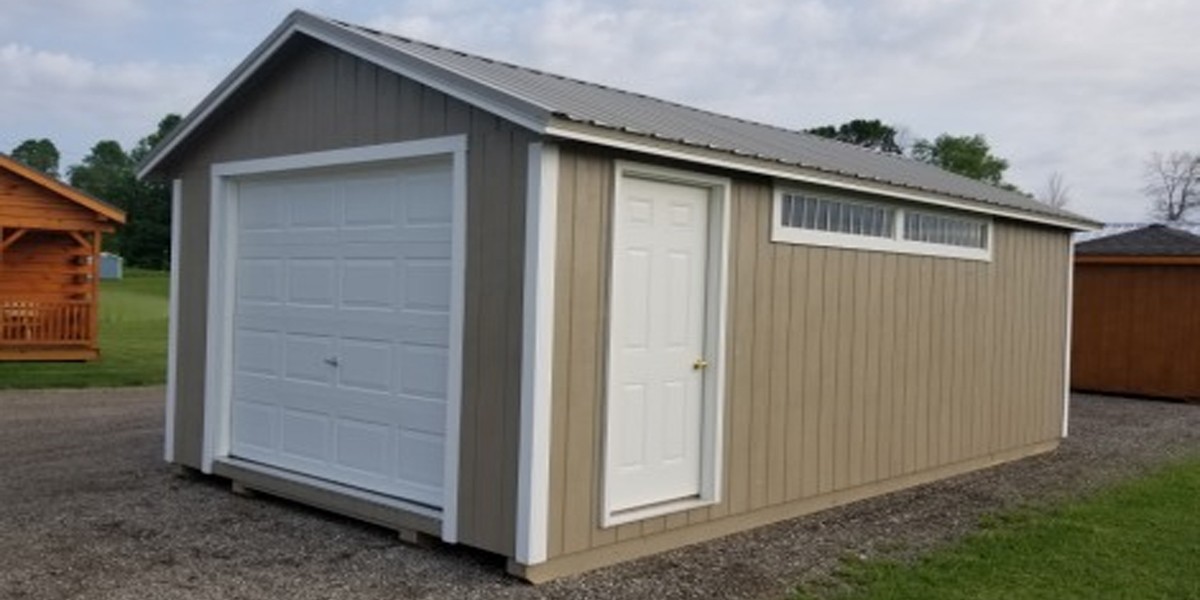When homeowners think about adding a shed, the gable shed often stands out as the most practical and timeless design. With its symmetrical roof and classic look, it fits beautifully into nearly any backyard style. But behind that simplicity lies a world of design choices that determine how functional, durable, and visually appealing your shed will be.
Whether you’re planning to store tools, create a small workshop, or design a backyard getaway, understanding key design features will help you build a gable shed that’s worth every penny.
1. Roof Pitch and Overhangs: More Than Just Looks
The gable roof is known for its two sloping sides that meet in the center, forming a triangle. While that might sound straightforward, the roof pitch (the steepness of the roof) plays a major role in how your shed performs.
A higher pitch helps with:
- Better water runoff, preventing leaks and standing moisture.
- More interior height, which adds ventilation and storage space.
- Improved aesthetics, giving the shed a classic, proportionate look.
Meanwhile, roof overhangs protect the siding from rain and sun exposure. Even a few extra inches of overhang can extend the life of your shed materials.
If you live in areas with heavy snowfall or rain, a steeper pitch and wider overhangs make your gable shed sturdier and more weather-resistant.
2. Choosing the Right Siding Material
The siding is not just about curb appeal, it defines how much maintenance you’ll need down the road. Common siding choices for gable sheds in Plymouth include:
- Wood Siding: Offers a warm, natural appearance and can be painted or stained. Needs periodic maintenance to resist rot.
- Vinyl Siding: Low-maintenance and durable against moisture, ideal for humid climates.
- Metal Siding: Long-lasting and resistant to pests, though it can be noisy in heavy rain.
- Engineered Wood: Gives the charm of real wood with better protection against decay.
For most homeowners, engineered wood or vinyl siding strikes the best balance between longevity and visual appeal. They also blend seamlessly with home exteriors, making the shed look like a natural part of your property.
3. Flooring and Foundation Choices
A gable shed’s stability depends on its foundation. The right flooring system not only keeps the structure level but also guards against moisture and pests.
Popular foundation options include:
- Gravel base: Economical and great for drainage.
- Concrete slab: Offers the strongest base for heavy storage or workshops.
- Pressure-treated wood platform: Easy to install and moisture-resistant.
Inside, a reinforced wooden floor gives you strength and flexibility, especially if you plan to store lawnmowers, bikes, or heavy tools.
4. Windows, Ventilation, and Natural Light
A well-designed gable shed is more than just walls and a roof—it’s a livable, breathable space.
Consider adding:
- Windows: Allow sunlight and create a welcoming environment.
- Ridge or gable vents: Encourage air circulation to prevent mold and odor buildup.
- Transom windows or skylights: Perfect for adding brightness without compromising wall space.
If your shed doubles as a workspace or hobby area, natural light can make a big difference in comfort and usability. It also reduces your need for electrical lighting during the day.
5. Door Placement and Size
The shed door is often overlooked, yet it defines how easily you can use the space. If you’re storing wide or tall items, double doors or barn-style sliding doors make access effortless.
Think about where the shed sits in your yard and how you move around it. A door that faces your main garden path or driveway often makes everyday use smoother. Also, consider adding a side door if your shed is large, it’s a small touch that boosts convenience.
6. Storage and Interior Layout
Your gable shed can do much more than just hold boxes. With a bit of planning, you can create an efficient storage layout that saves space and keeps everything within reach.
Smart interior features include:
- Loft space: Ideal for seasonal storage, thanks to the gable roof height.
- Wall-mounted shelves or pegboards: Keep tools and accessories organized.
- Built-in workbench: Perfect for DIY or gardening projects.
The gable design naturally offers extra overhead space, making it ideal for homeowners who need both vertical and floor storage.
7. Trim, Paint, and Exterior Finishing Touches
Your shed’s exterior finish says a lot about your home’s overall style. Trim color, door design, and roof shingles should complement your house to create visual harmony.
For a rustic feel, go with wood accents and earthy tones. For a modern look, choose crisp whites, grays, or contrasting trims. Even small details, like decorative shutters or window boxes, can elevate your shed from a simple storage unit to a charming backyard feature.
8. Energy Efficiency and Weather Protection
If you plan to use your shed year-round, consider adding insulation and weatherproofing. It helps maintain stable indoor temperatures, protects your belongings, and keeps the structure in good condition.
- Insulate the roof and walls to regulate temperature.
- Seal gaps and joints to keep pests and moisture out.
- Use durable roofing materials like asphalt shingles or metal panels to prevent leaks.
This not only protects your shed’s contents but also ensures it remains a comfortable and long-lasting space.
9. Personalization and Curb Appeal
A gable shed in Kewaskum gives you a blank canvas to reflect your personality. Add flower boxes, a small porch, or even decorative lighting to make it blend beautifully with your outdoor space. Many homeowners use their gable sheds as garden studios, mini offices, or playhouses, turning a simple structure into a part of their lifestyle.
Your shed doesn’t have to be hidden, it can become a feature worth showing off.
10. Budgeting for Long-Term Value
While it’s tempting to go for the lowest cost option, investing in quality materials and thoughtful design ensures your gable shed lasts decades. A well-built shed adds property value, improves storage efficiency, and saves you from frequent repairs or replacements.
Bottom Line:
There’s something satisfying about seeing a gable shed standing proudly in your backyard—balanced, strong, and designed just the way you wanted. At MW Sheds, we turn those ideas into structures that fit your home, your taste, and your everyday needs. No cookie-cutter styles or rushed builds. Every shed we craft is meant to look like it has always belonged in your yard.
So, if you’re ready to bring practicality and charm together, start your shed story with MW Sheds today. Let’s make your backyard space smarter, sturdier, and unmistakably yours.
FAQs
1. What makes a gable shed better than a basic flat roof shed?
A gable shed offers better drainage, improved ventilation, more headroom, and a classic look that boosts durability and backyard appeal.
2. How important is roof pitch in a gable shed design?
Roof pitch affects water runoff, snow handling, interior space, and overall strength, making it crucial for long-term performance and protection.
3. Which siding material lasts longest on a gable shed?
Engineered wood or vinyl siding offers durability, moisture resistance, low maintenance, and strong weather protection compared to traditional wood.
4. Do window placements matter in a gable shed layout?
Proper window placement increases natural light, ventilation, comfort, and helps reduce moisture buildup, especially when using the shed regularly.
5. Why should homeowners consider overhangs on a gable shed?
Overhangs protect siding from harsh weather, reduce water damage, extend paint life, and improve overall structure longevity.

